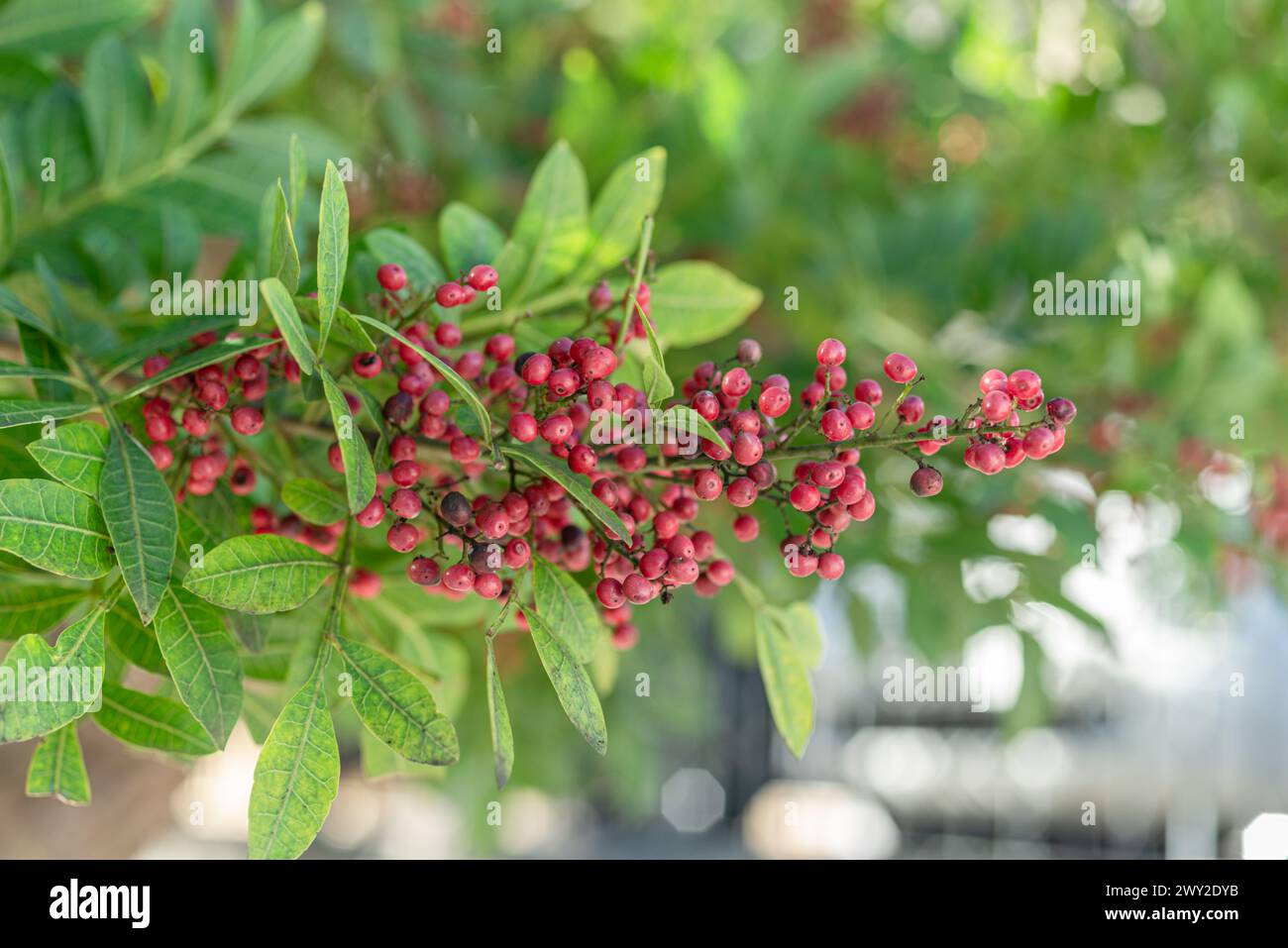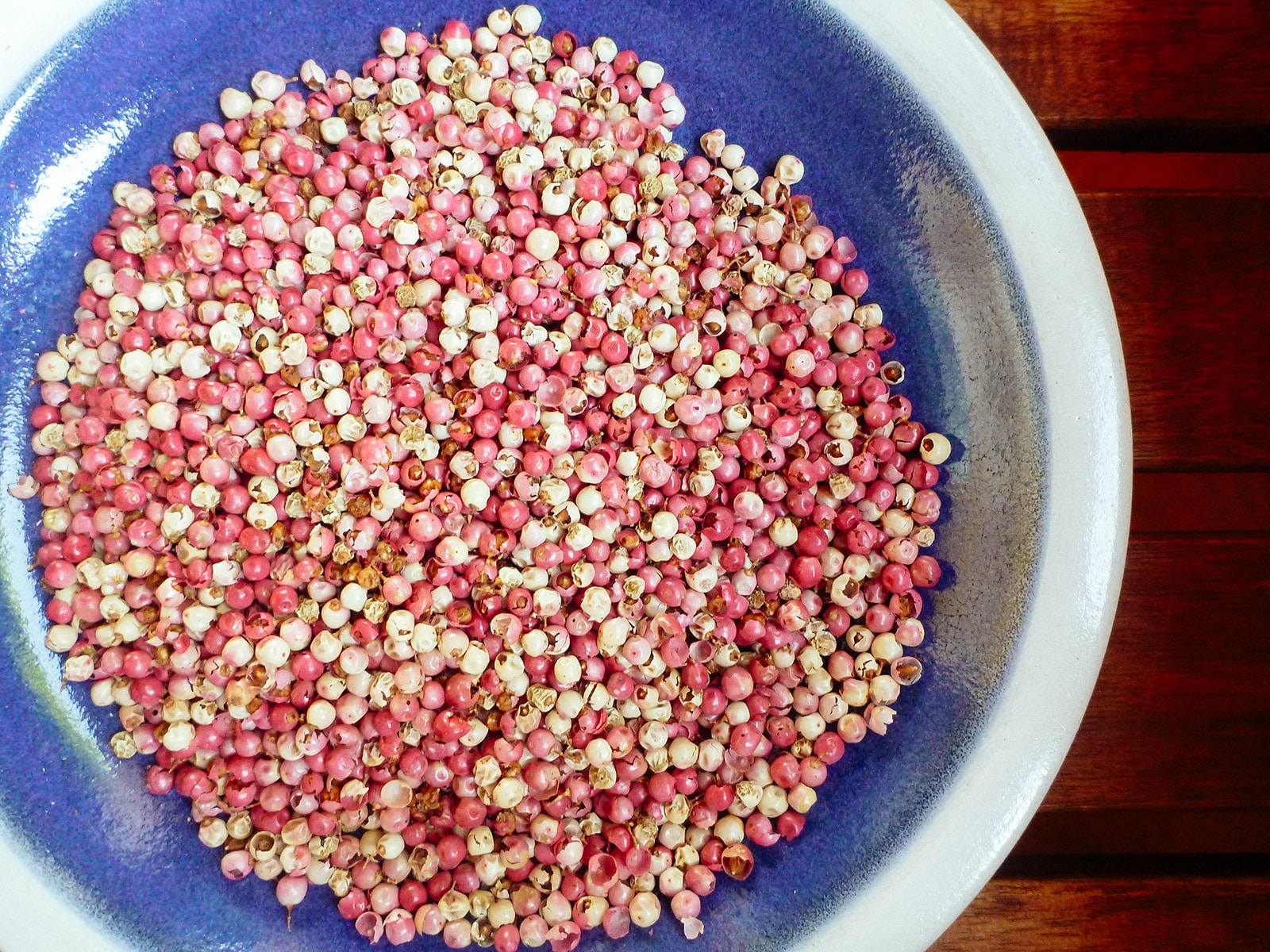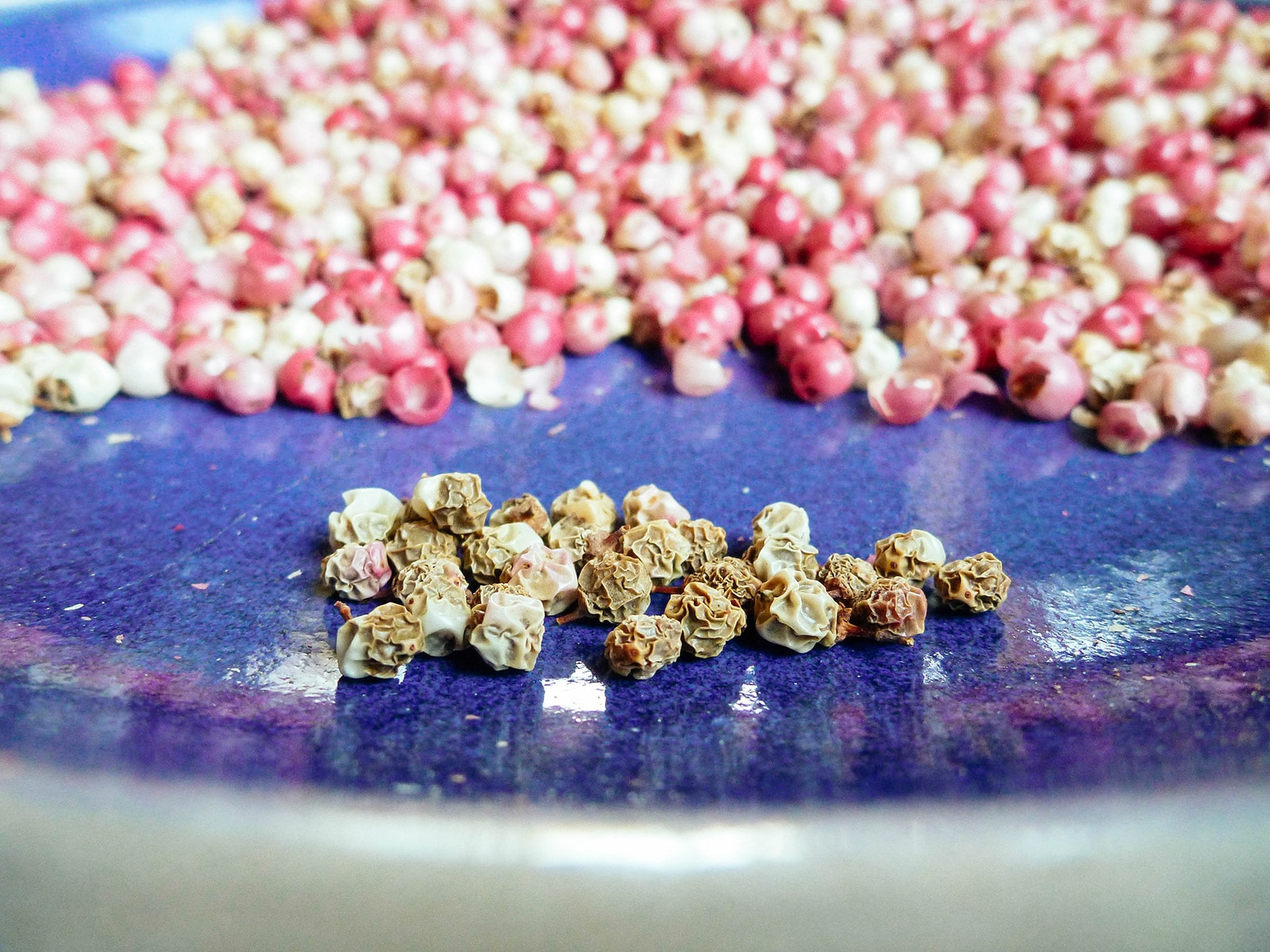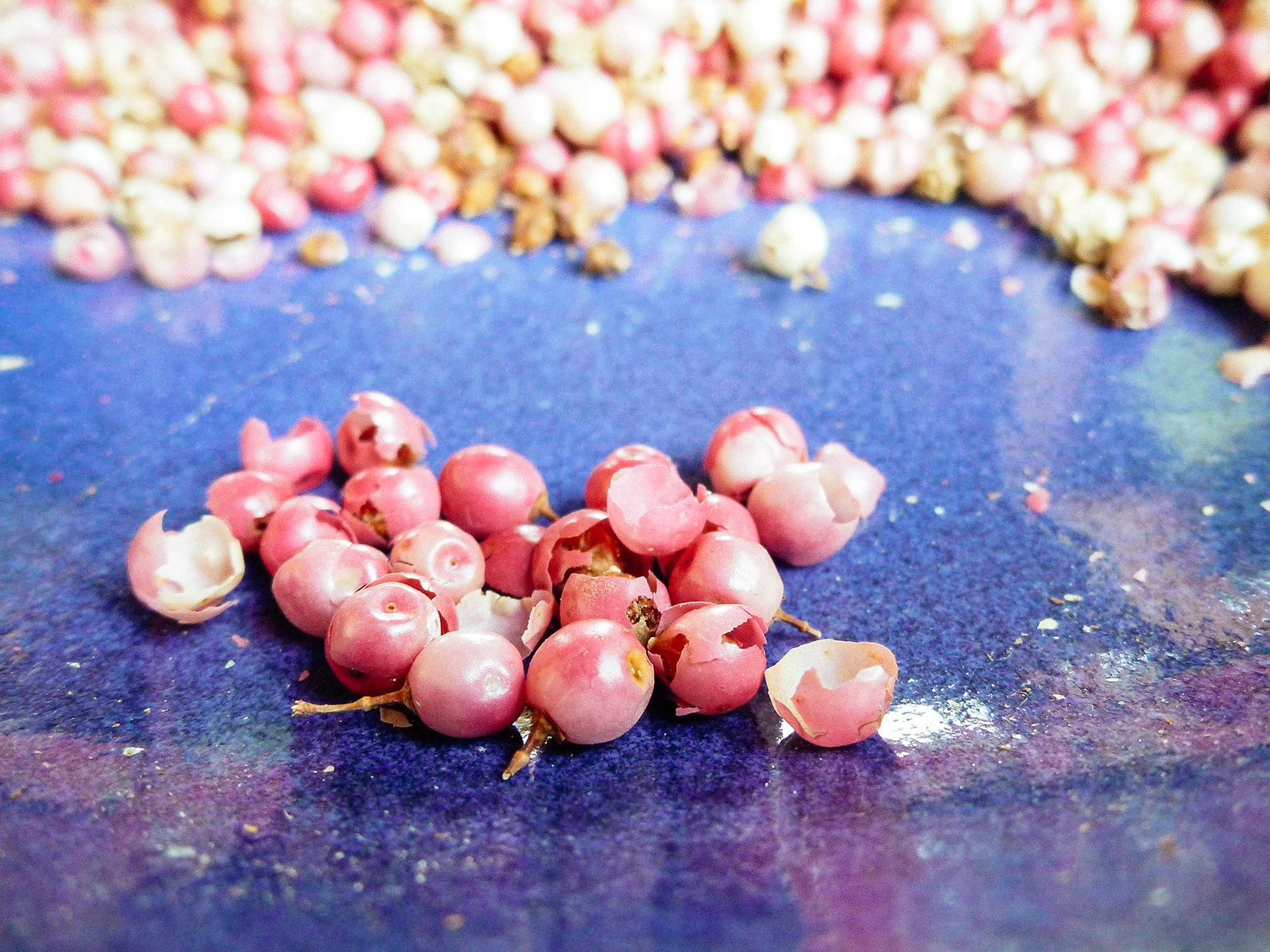If you think about it, wild food is everywhere around us. Our backyards have dandelions growing so rampant, we constantly try to eradicate them.
Public fruit trees beg to be gleaned, miner’s lettuce is a weed with a gourmet reputation, easy hikes will bring you upon scores of stinging nettles and fennel.
The East Coast has ramps springing up every year in shady woodlands. Northern California has chanterelles and blackberries in abundance.
And in Southern California, there’s Peruvian pepper, also known as the pink peppercorn tree. These are the same pink peppercorns you see in stores as a gourmet spice, packaged in small, expensive jars and called for in fancy cookbooks.
But in Southern California and other parts of the country, bucketfuls of these vibrant berries litter the ground in suburban neighborhoods all through fall and winter, free for the taking. More often than not, they’re dismissed as a nuisance by the gardener who has to rake them all up.
It almost seems like a food crime to let heaps of peppercorns lay forgotten when just a few miles away, they command upwards of $10 an ounce at specialty spice shops.
Because while they look like (and are often grown as) landscape ornamentals in residential backyards and municipal sidewalks, the pink peppercorns from Peruvian pepper trees are 100 percent edible!
The pepper tree is a unique and versatile plant that produces edible pink peppercorns. Though it may look like just another ornamental tree this plant has a long history of culinary and medicinal uses. Let’s explore the many benefits of the pepper tree and its pink berries.
The pepper tree (Schinus molle) is an evergreen tree native to the arid Andean region of South America. It thrives in warm climates and has become naturalized in parts of the southwestern United States, including California, Texas, and Florida. The pepper tree is known by many names, including Peruvian pepper, American pepper, California pepper tree, and pirul.
This fast-growing tree can reach up to 50 feet tall and wide. It has graceful, drooping branches that give it a willow-like appearance. The fern-like leaves are aromatic when crushed. Clusters of tiny white flowers bloom in spring and summer, developing into bright pink or red berries in fall and winter. These pink peppercorns are the tree’s claim to culinary fame.
The History and Uses of the Pepper Tree
The pepper tree has a long history of use by indigenous South American cultures. Archaeological evidence shows the Wari and Inca civilizations used pepper tree berries to make a fermented beverage called chicha. During the Spanish colonial era, pepper trees were prized for their durable wood, which was used to make saddles.
When Spanish missionaries brought pepper trees to California in the late 1700s, the trees became a recognizable symbol of the missions Pepper trees were widely planted in California during the late 1800s for their shade and drought tolerance. For a time they were hailed as an iconic street tree in Southern California. However, problems like invasive roots and a susceptibility to pests diminished their popularity as a municipal tree.
In addition to food and timber uses, indigenous peoples used pepper tree leaves medicinally for their antiseptic properties. Andean cultures also made a natural dye from the leaves. Today the essential oil is used in perfumery.
Pink Peppercorns – The Tasty Treats
The real star of the pepper tree is its pink peppercorns. Though unrelated to commercial black pepper, the outer fruit layer surrounding the pepper tree seed is dried and sold as pink peppercorns. They offer a sweet, slightly spicy flavor with hints of citrus and mint.
Pink peppercorns are hand harvested when the drupes or berries turn from green to rosy pink on the tree. After picking, they are dried naturally until the berries shrink and the outer fruit layer separates from the inner seed. At this point, both the dried fruit shell and seed can be used whole as pink peppercorns.
Since the 1980s, pink peppercorns have regained popularity as an exotic seasoning. They are packaged on their own or blended with regular black, white, and green peppercorns. Pink peppercorns pair well with fruit, chocolate, cheese, poultry, and seafood. Their milder heat complements without overpowering other ingredients.
While related to poison ivy and poison sumac, pink peppercorns are not toxic. However, like cashews, they could cause a reaction in those with specific plant allergies. Since pink peppercorns are not true pepper, be sure to read labels to check for adulteration.
How to Forage for Pink Peppercorns
Foraging for pink peppercorns is a fun outdoor activity in late fall and winter. Look for trees loaded with ripe pink berry clusters, especially branches drooping near the ground. Obtain permission from the property owner before foraging.
Carefully snip off peppercorn branches without damaging the tree. At home, strip off the drupes and discard any leaves or stems. Spread berries on a tray to dry indoors or in a sunny spot. Turn the berries a few times to ensure even drying. Cool, dark storage preserves the peppers’ aroma and flavor.
Now you can enjoy homemade pink peppercorns as a zesty seasoning or unique holiday gift. Try grinding them over deviled eggs or add to a rub for salmon. Infuse vinegars, oils, and cocktails with pink peppercorns for a pop of flavor. Your foraged pink pepper harvest offers culinary versatility all season long.
Growing Your Own Pepper Tree
If you live in zones 9-11, consider growing a pepper tree for ornamental beauty and pink peppercorn bounty. Pepper trees thrive in full sun with low or moderate watering. They adapt to most soils as long as drainage is good.
Start new trees from seed, cuttings, or container transplants. Pepper trees self-sow readily, so watch for volunteer seedlings under the canopy. Male and female flowers grow on separate trees, so plant both to ensure fruit production. Prune as needed to shape the tree and thin excessive fruit clusters.
With its airy, graceful form and flashy pink berries, the pepper tree makes a unique addition to gardens in warm climates. Enjoy watching birds flock to the tree for a winter feast. Then harvest the leftover peppercorns for your own festive recipes.
The Pepper Tree – More Than Just a Pretty Face
With its long history and many uses, the versatile pepper tree is much more than a landscape ornamental. The same tree that shades your yard in summer can provide a zesty pink peppercorn spice blend when winter arrives. Forage from neighborhood trees or grow your own small pepper tree orchard.
The next time you spy a pepper tree dripping with pink berries, don’t dismiss it as just another “weed tree.” Look closer and discover a bounty of edible pink peppercorns waiting to be harvested.Blend them into your favorite recipes or give homemade pink pepper spices to friends and family. Let the pepper tree spice up your winter!

Step 2: Dry the peppercorn berries.
Gently pull the fresh berries off the branches with your fingers. Sometimes I’m able to do this quickly by running my fingers firmly down a branch to strip off the berries (the way you might take thyme or rosemary leaves off a stem).
Don’t worry if you get some stems in the mix—though it won’t give you a “clean” harvest, there’s no harm in having a few bits and pieces of stems in with your spice.
Spread the berries out on a plate or cookie sheet, and leave them out on the counter to dry at room temperature.

Within a few days, the berries will fully dry and harden into peppercorns.
A Peruvian pepper berry consists of a shell surrounding a single seed. During the drying process, the shell may crack and separate to reveal a brownish pink seed inside.
This separation is similar to how white peppercorns are made—the outer shells are removed from the berries of black pepper plants and the seeds themselves become white peppercorns.
If your berries are dried in a sunny spot, the shell may become bleached as it shrinks around the seed to create the hard, wrinkled outer layer so familiar as peppercorns.

Sometimes the shell stays intact and you’ll have smooth peppercorns, but you can eat any of these pink peppercorns (shelled or not).

Step 1: Look for branches with ripe pepper tree berries.
Cut off a segment of branch with a good amount of reddish-pink berries on it. They’re easy to find as they’re usually the clusters draping off the ends of the tree.

Sacred Peruvian (California) Peppertree – Schinus molle
FAQ
Are pink peppercorn trees edible?
Pink peppercorns as food
It can be used as a spice in a variety of recipes, both savoury and sweet. As the seeds are quite oily, it is not easy to grind them when fresh, so it is best to dry them fully first. I use the berries sparingly as a spice when I cook (it is rather hot), and love their floral flavour.
Can you eat pink peppercorns off the tree?
Peruvian pink pepper tree (Schinus molle) are considered safe to eat. Later that week, we did a little research in the spa library as well as on our phones, and discovered that it was indeed edible pink peppercorn that he found. It turned out that there are two species of trees growing on the property.
Can you get pepper from a peppercorn tree?
Known by many names including false peppertree, Peruvian peppertree, Peruvian mastic tree, Chilean peppertree and California peppertree, Schinus molle is not actually related to true pepper (Piper sp.) but does produce spicy berries often used as pink peppercorns on the female plant.
Where does pink peppercorn come from?
The classic pink peppercorn comes from the Peruvian pepper tree (Schinus molle), which is also called the California pepper tree (although it’s particularly invasive in Florida and Hawaii).
How do you harvest pink peppercorns?
Harvesting pink peppercorns is as simple as collecting a few clusters of berries from a Peruvian pepper tree. Step 1: Look for branches with ripe pepper tree berries. Cut off a segment of branch with a good amount of reddish-pink berries on it. They’re easy to find as they’re usually the clusters draping off the ends of the tree.
What family does the pink peppercorn tree belong to?
Here’s an interesting chapter in the pink peppercorn tree’s family history that most people don’t know… The Peruvian pepper tree belongs to Anacardiaceae, otherwise known as the cashew family, a group that also includes poison sumac, poison oak, and poison ivy.
Are pink peppercorn trees evergreen?
Shinus molle, or pink peppercorn, is an elegant tree native to South America. Pink Peppercorn facts, a short list Foliage: evergreen – Blooming: spring → fall – Fruit set: summer → fall It is recommended to plant pink peppercorn in spring, for it to avoid starting off by having to face winter. Refer to our guidelines on planting shrubs.
Is pink peppercorn a good shade tree?
Pink Peppercorn is an excellent shade tree that resists cold temperatures down to 23°F (-5°C). Images: 123RF: Rafael Santos Rodriguez; own work: Rosalyn & Gaspard Lorthiois Proper planting and care to keep your false pepper in great shape. Shinus molle is an ornamental tree bearing a spicy berry: pink peppercorn.
Are pink peppercorns edible?
Because while they look like (and are often grown as) landscape ornamentals in residential backyards and municipal sidewalks, the pink peppercorns from Peruvian pepper trees are 100 percent edible! Related: Common vegetables you grow that you didn’t know you could eat
